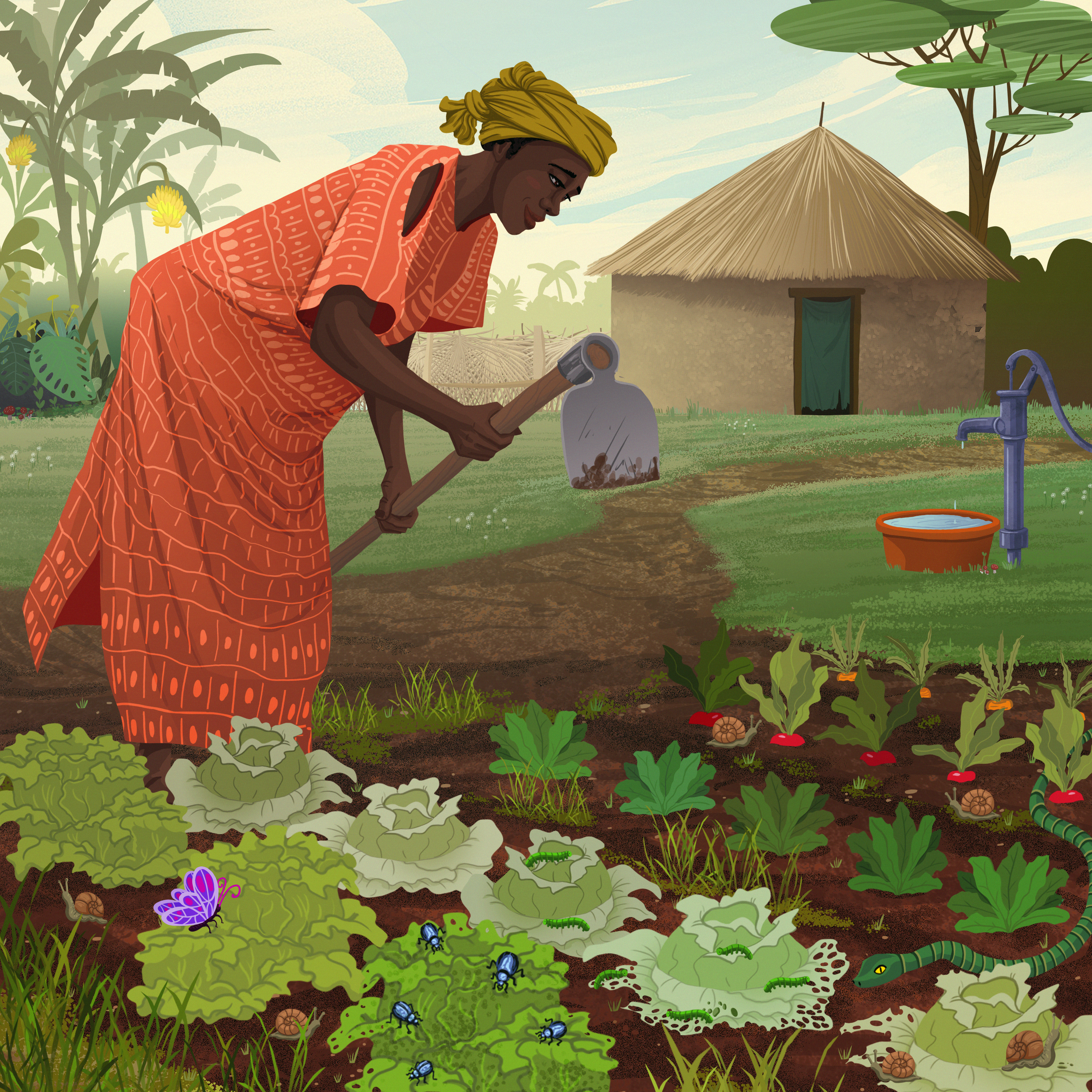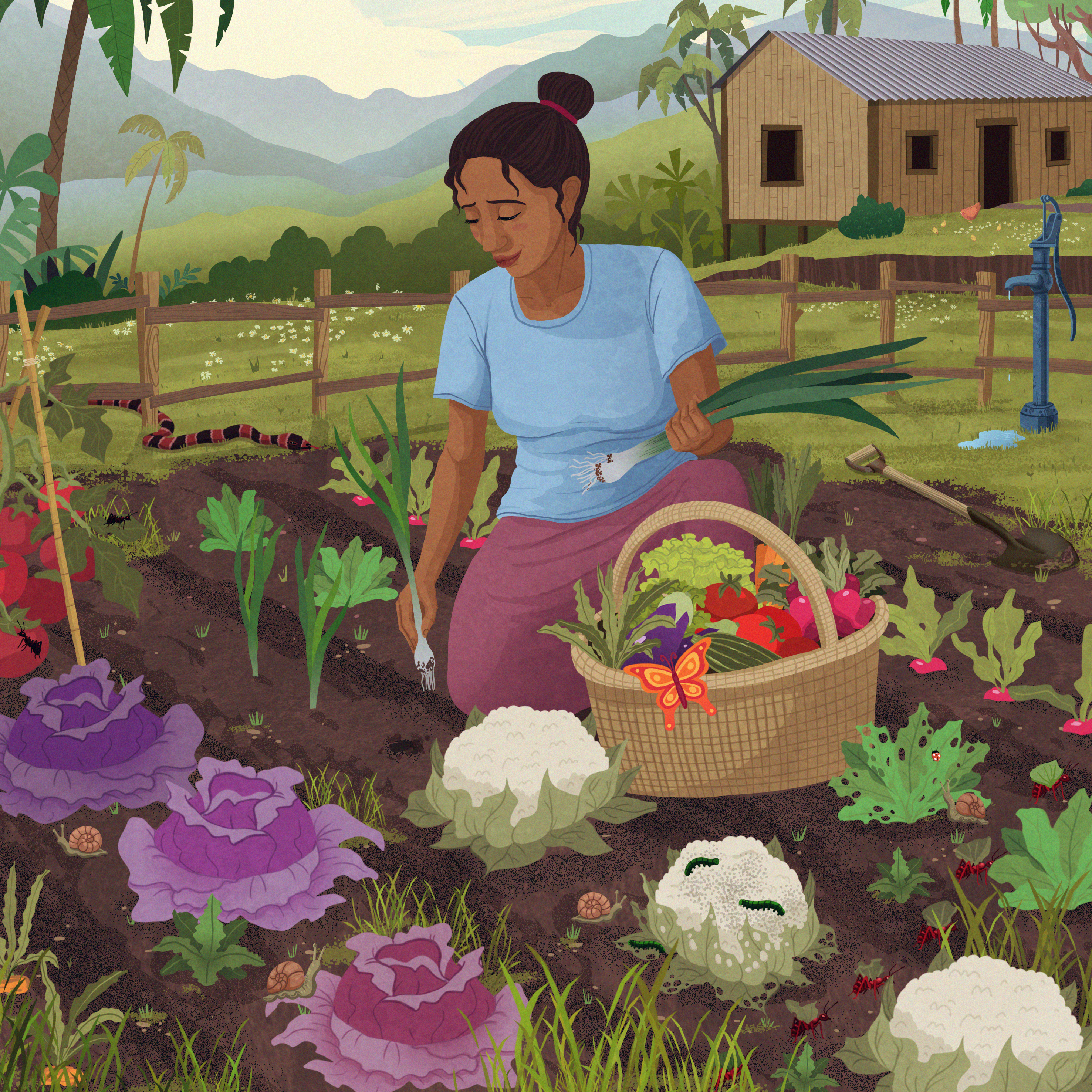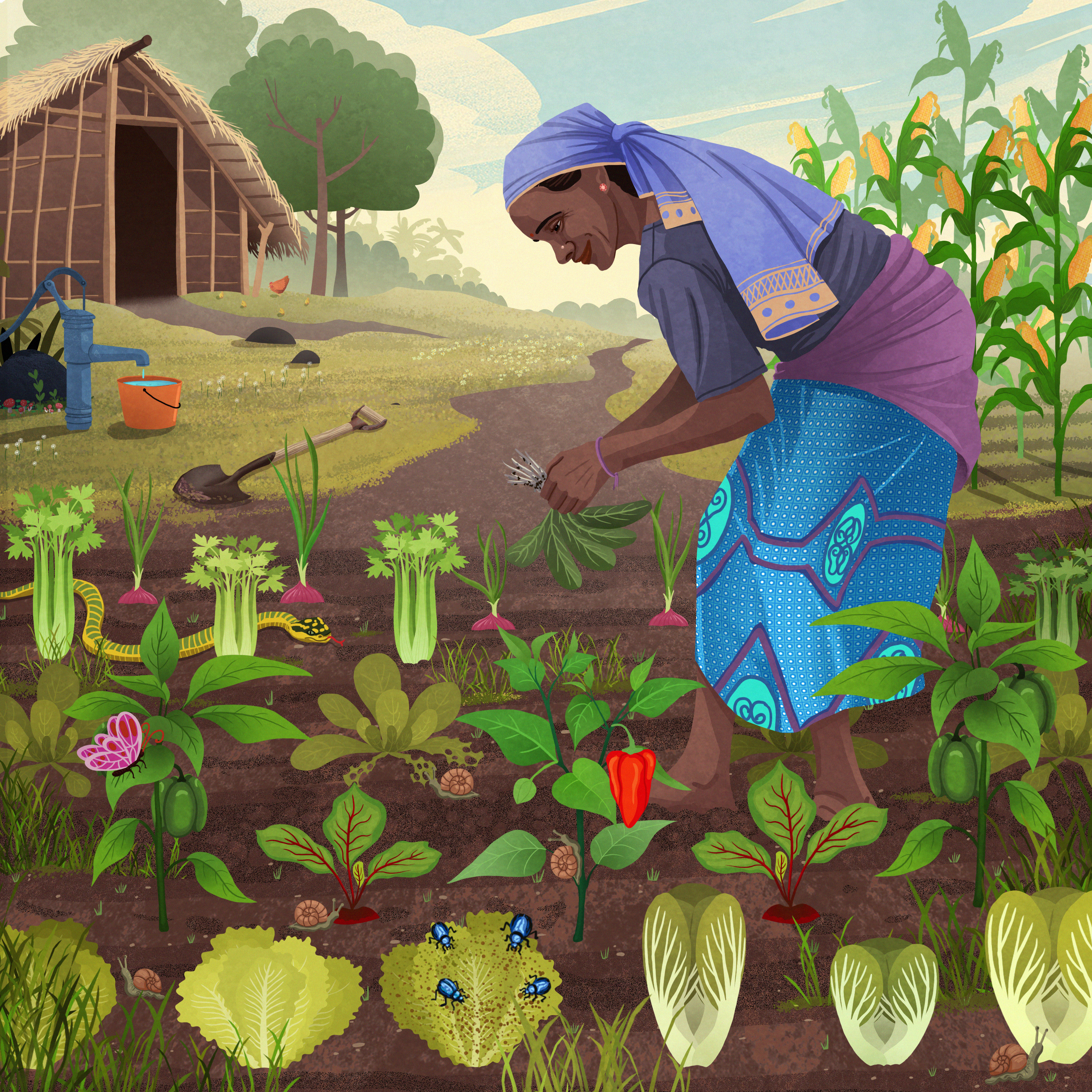Global Child Protection Parenting Curriculum
Year 1, Lesson 7: A Damaged Garden - Isolation, Powerlessness and Impurity
Time Needed: 45 minutes
Garden Images:



Index
Teacher Preparation
Introduction
New Ideas
Story
Application/Activity
Reflection & Caregiver Connection
Closing
Teacher Preparation
Objectives
The caregiver will be able to:
- Hear a Bible story about how trauma and hardship lead to lies about isolation, powerlessness, and impurity.
- Describe lies of isolation (I am alone), powerlessness (I have no power) and purity (I am impure and cannot be cleansed) that happen as a result of abuse.
- Explain the importance of replacing these lies with truth.
- Explore how a parent’s beliefs about belonging, empowerment and purity lead them to pass these same messages to their children.
- Explore culturally appropriate ways of expressing belonging, empowerment and purity to a child.
Materials
- Notebook
- Chalkboard and chalk
- Two vases, jars or glasses filled with water
- Food coloring
- Bleach
Preparation
- Read the lesson and reflect on how to teach it wisely.
- Skim previous lesson. Prepare to have a quick review at the beginning of class.
- Prepare the glasses of water. Fill one with clear water, another with food coloring in the water, and another with bleach. Place them at the front of the classroom. In the lesson activity, when you add the bleach to the colored water, it will lighten or even remove the color from the water.
Introduction
5 minutes
![]()
In our last lesson, we discussed how to communicate effectively with our children. What five practices did we learn that help us do this well? As you read each one, demonstrate the hand motion and invite the participants to do this with you.
- Watch (point to eye)
- Listen (point to ear)
- Ask (open hands with palms up to illustrate openness)
- Speak (point to mouth)
- Think (point to head)
Allowing for safe and healthy communication at home enables children to report to their caregivers if they have faced or fear potential abuse. However, we have discussed in earlier lessons how without encouragement and safety, most children resist sharing with others that they have been abused, even though exposing abuse provides a path to healing for all involved. Today we will explore the common experiences that people tend to have when wrongs are hidden and ignored.
Hold up the vase, jar, or glass with clear water for all to see. This jar represents a child’s heart before painful experiences from wrongs done to and through them have occurred.
- How does it look? Clean, transparent, clear, etc.
Hold up the vase, jar or glass with colored water for all to see. This represents a child’s heart after painful experiences from wrongs done to and through them have occurred.
- How does it look? Colored, opaque, difficult to see through, unclean, etc.
When our minds, bodies, and hearts are hurt through doing wrong or receiving it, our insides change just like this water. We no longer grasp truth clearly and instead, we believe lies. When a child is an abuse victim, such lies are especially powerful.
New Ideas
5 minutes
![]()
We will start today with a summary of a story from the Bible about a slave whose owners abuse her. Imagine how she feels during and after her will is violated.
Genesis 16:13
A special couple in God’s story, Abraham and Sarai, had a slave named Hagar. When Abraham and Sarai did not become pregnant as God had promised them, they grew tired of waiting and Sarai chose to give Hagar to Abraham so together they could produce an heir (an accepted practice at the time).
Once Hagar became pregnant, jealousy drove Sarai to abuse Hagar with Abraham’s permission until her slave ran away. While Hagar escaped through the desert, God met her there. He spoke to her lovingly about his plan for her and her future child, giving her hope. The story says that Hagar responded:
13 …She said, “You are the God who sees me.”
- Based on what you learned about Hagar being a powerless slave, why do you think she did not feel seen in this story until she met God in the desert? The answer is not directly in the story. Help the participants imagine how Hagar felt. Allow them to explore. Possible answers include: She was a slave; she did not have a choice in having sex with her master; when she conceived as planned, instead of thankful, Sarai was jealous; instead of addressing the jealousy between the women, Abraham and Sarai physically and emotionally abused her; Abraham and Sarai did not care about how this hurt her body, mind, or heart; Hagar likely felt helpless, hopeless, powerless, and alone.
People who are abused often believe lies, lies that tell them they are alone, powerless, worthless, and at times impure. The same lies that are true for a powerless slave woman are true for a powerless child who is a victim of abuse.
Caregivers also believe lies when their children are abused. Most abusers are close relatives, friends, or neighbors of a child. Caregivers can find it difficult to accept this truth and confront evil with people who are close to them, just as Abraham and Sarai ignored their own wrongs toward Hagar.
Story
15 minute
![]()
Listen now to a modern story about how a family responds to one of their children being abused. Pay special attention to what different family members believe about their daughter’s situation:
Story
The Fernando family was in a state of shock at what had happened to their daughter Maya. When Mr. Fernando heard that Maya had been raped by Suhan, his son’s friend, he was outraged that his daughter had been sullied in this way. She was stained forever and who would ever marry her now?
Their good name in the community was destroyed forever and they could do nothing to change it. Anger and a desire for revenge stirred in Mr. Fernando’s heart. How might he avenge his daughter’s shame? How might he ruin Suhan and his family for destroying his daughter forever?
Mrs. Fernando imagined how the neighbors would gossip about their family once word got out that Suhan had taken advantage of Maya. One neighbor would surely say, “If Maya was our daughter, she most certainly would not have been taken advantage of in this way!” Or, another neighbor might say, “I am grateful not to be the Fernando family. We all had admired them so, but not anymore!”
Mrs. Fernando secretly imagined the community’s pleasure at their family’s downfall as it lifted everyone else’s standing in the community. She made plans to avoid contact with everyone for as long as possible, strategizing that she could shop early in the day before most people had left home.
Though their house was small, Maya found the most private space possible and sat alone, turned away from everyone. She could not see how she could move past what had happened to her. Filth seemed to cover her, as if Suhan’s unwelcome treatment had made her permanently unclean.
She saw herself alone in a deep pit, one that enveloped and trapped her, preventing her from any hope of escape. Her dark mood overwhelmed her, as she reflected on her life’s cruel circumstances and the shameful, disturbing memories that she now had. She wished that she would die, and it frightened her to think such thoughts. What hope could she now have?
Discuss the following questions with the participants:
- Maya, the Fernandos’ daughter, is attacked by her brother’s friend. Is this her fault? No.
- What does Mr. Fernando think and feel after this event? Reread paragraphs 1 and 2 if needed, encouraging them to name as many as possible. Answers are: outrage; that Maya is stained forever and will never marry; their family’s good name is stained forever and they are powerless to change that. He thinks about getting revenge on Suhan.
- What does Mrs. Fernando think and feel after this event? Reread paragraphs 3 and 4 if needed, encouraging them to name as many as possible. Answers are: the neighbors will gossip and blame the family for what happened. Their family will be viewed as a failure. Other people will enjoy their shame, as it uplifts their own status. She plans to isolate herself so that she sees no one.
- What does Maya think and feel after what happened to her? Reread paragraphs 5 and 6 if needed. Answers are: She feels alone and permanently unclean. She has no hope of escape. She’s overwhelmed by darkness and disturbing memories. She wishes she could die.
This is an unpleasant story, and we likely feel uncomfortable discussing and even thinking about it. However, when we take time to consider the reality of such situations, it helps us explore the possibility of hope.
- Our story addresses a single event that happens to Maya and is told from three people’s point of view. What are some common thoughts that they all have? Reread parts of the story as needed and then accept all answers. Then explain that all three people believe that Maya’s rape leaves her and the family dirtied and unacceptable to others. They all believe there is nothing they can do (though Mr. Fernando does plan revenge), and they all believe that they are alone in this situation.
Experiences of abuse such as described in this story usually leave the victims and their families believing three core things: that the victim is stained, dirtied and unacceptable; that the victim is trapped and powerless; and ultimately that the victim and family are alone in their shame.
- Based on what you heard in the story, who do you think has been most damaged by Suhan’s actions—Mr. or Mrs. Fernando, or Maya herself? Discuss this question with a neighbor. Give participants a minute or so. Then allow the pairs to respond to the question. Though it is possible that some participants will believe that the family is the most damaged, encourage them to consider Maya’s point of view. She has the sense of being dirty in her own body; she has dark, disturbing memories from the abuse and she wishes that she were dead.
Both Mr. and Mrs. Fernando do imagine ways that they might respond to Maya’s situation. Mr. Fernando thinks about how he can take revenge on Suhan. Mrs. Fernando thinks about how she can avoid others in the community. Also, what happens to Maya is a criminal offense and Mr. and Mrs. Fernando should have reported it to the proper authorities to encourage justice. However, both parents are primarily concerned about their own involvement.
When a child is abused, though it does affect the entire family, the child experiences the greatest consequences, as the child’s body, mind and heart receive the experience of the abuse. We should take note that each family member has a strong reaction to this event, but no one pays attention to Maya and her needs. Who will help her?
Application/Activity
15 minutes
![]()
We will begin our activity today with a demonstration. Hold up the clear and colored jars of water. The clean water represents Maya’s heart and mind before her abusive experience. The colored water represents her heart and mind after her abusive experience.
- What do you think the colored water might represent? Allow the participants time to consider this question. Possible answers are: her fear and hopelessness; her desire to die and other dark thoughts; her loneliness, etc.
These dark thoughts and feelings are lies that we all believe at times, but the ones that victims of abuse experience are especially intense and damaging. These lies can wound victims for a lifetime as they come to believe that they are forever stained, alone and powerless. These inner lies may not be obvious to others, but they prevent a victim from believing that they can have hope and make good, positive decisions for their future.
Often the community and the parents that surround the victim support these lies as well—they, too, believe that the victim is stained and treat the victim accordingly. Rather than providing support, love, and hope, parents communicate agreement with these lies.
I have a third liquid here. Let’s see what happens when I add this third liquid to the colored water. Hold up the glass of bleach and carefully pour it into the glass of colored water. Hold up the colored water so that the participants can see its color lighten and even clear up entirely as the bleach is added.
- If the colored water represents lies that we might believe, what might this third liquid represent as it removes the color from the water? Accept all answers, but conclude together that it represents the truth.
We all know that loving others, our children especially, is good and right. Truth that shares such love with an abuse victim is what replaces lies. Once we become aware that every victim is worthy of love and hope, parents can turn away from social stigmas that discourage victims and share hope instead. God can strengthen and lead parents into sharing this crucial truth. Keep this in mind as you do the next part of our activity.
The last part of our activity for today involves storytelling. Get into groups of 3-4 people and together invent a positive ending to this story, one where Maya’s needs for love and truth are addressed.
- How might she stop believing lies that she is forever stained, alone, and trapped? How might others respond? Be creative!
Allow the participants to get into groups of 3-4 people. If they struggle with the activity, explain that you are not looking for a right answer, but just want them to think creatively about sharing love and hope. After 5-10 minutes, allow each group to share their ending to the story.
This activity is designed to get the participants thinking about how to communicate love to another, but keep in mind that the next lesson will explore more specifically how truth replaces lies.
Reflection & Caregiver Connection
4 minutes
![]()
In situations of abuse, it is common for others to simply accept the lies that the victim and they themselves might believe.
- Why do you think that happens? Though the question may be new and difficult, encourage the participants to take a moment of silence and consider this important question. Then accept all responses. Some possible answers are: the experience is too painful for others to address; they have never observed anyone handle such situations differently; their families did not address their needs; they do not know what to do, etc.
Our family, community, and culture may not have taught us how to have hope in the face of difficult circumstances. In our story, not only does Maya’s abuse lead her to believe lies that she is dirty, trapped and alone, but her parents believe these lies as well. Unless their perspectives change, they will find it difficult to provide hope to Maya.
Just as you created a positive ending to our story, one way our perspective can change is to consider God’s truths we can tell our children that are opposite to these lies. Take another moment of silence and respond to this question:
- How could I communicate to a child that they belong (and are not alone); that they are not trapped, but have hope; and that they are not forever dirty, but can become clean? Allow another moment of silence.
- What ideas came to mind? Accept all answers.
Caregiver Connection
If you discover your child has been abused, invite God to meet them where they are in their despair. Then try to do the same through acts, such as:
- Believe them; acknowledge the depth of violation and pain.
- Prioritize their healing over all else, even your own emotions.
- Protect them from future harm.
- Tell them the truth that what happened to them was wrong and not their fault; that it does not diminish their worth; and that they can still hold hope for the future.
Closing
1 minute
![]()
Our next lesson will focus more specifically on the good news that we can share with our children; that no painful circumstance is beyond God’s love and hope. Just as you practiced in our activity today, even painful circumstances can lead to a positive future.
Until our next class, look for opportunities to share love and hope when others are experiencing hopelessness and isolation.
![]()